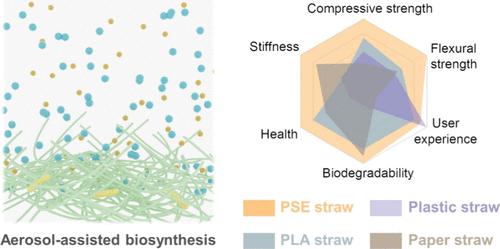利用生物制造技术培养具有内在结构粘合剂的强多糖来源的可食用秸秆
IF 9.1
1区 材料科学
Q1 CHEMISTRY, MULTIDISCIPLINARY
引用次数: 0
摘要
通过生物制造开发与食品有关的材料有望克服塑料等传统材料带来的微塑料和聚氟烷基及全氟烷基物质的风险。在这里,我们报告了一种制备高性能多糖衍生可食用(PSE)吸管的生物制造策略。在生物合成过程中,淀粉被均匀地整合到细菌产生的三维纤维素纳米网络中。淀粉通过相变填充纤维素纳米网络的孔隙,作为一种固有的结构粘合剂,增强了纤维素纳米网络的互穿性,极大地增强了PSE秸秆的层间结合。值得注意的是,生物制造网络结构和高密度氢键使PSE秸秆具有出色的强度、模量和热稳定性,超过了市购秸秆。这种生物制造策略可以制造可食用吸管作为塑料的健康替代品,并为通过生物合成开发新型环保和高性能材料铺平道路。本文章由计算机程序翻译,如有差异,请以英文原文为准。

Growing Strong Polysaccharide-Derived Edible Straws with an Inherent Structural Binder via Biomanufacturing
Developing food-related materials via biomanufacturing is expected to overcome the risks of microplastics and poly- and perfluoroalkyl substances posed by traditional materials such as plastics. Here, we report a biomanufacturing strategy to prepare high-performance polysaccharide-derived edible (PSE) straws. Starch is uniformly integrated in situ into the three-dimensional cellulose nanonetwork produced by bacteria during biosynthesis. The starch undergoes phase transitions to fill the pores of the cellulose nanonetwork as an inherent structural binder that reinforces the interpenetrating network and greatly enhances the interlayer bonding of the PSE straws. Notably, the biomanufacturing network structure and high-density hydrogen bonds endow PSE straws with outstanding strength, modulus, and thermal stability, surpassing those of commercially available straws. This biomanufacturing strategy can fabricate edible straws as a healthy substitute for plastics and pave the way for developing new kinds of eco-friendly and high-performance materials via biosynthesis.
求助全文
通过发布文献求助,成功后即可免费获取论文全文。
去求助
来源期刊

Nano Letters
工程技术-材料科学:综合
CiteScore
16.80
自引率
2.80%
发文量
1182
审稿时长
1.4 months
期刊介绍:
Nano Letters serves as a dynamic platform for promptly disseminating original results in fundamental, applied, and emerging research across all facets of nanoscience and nanotechnology. A pivotal criterion for inclusion within Nano Letters is the convergence of at least two different areas or disciplines, ensuring a rich interdisciplinary scope. The journal is dedicated to fostering exploration in diverse areas, including:
- Experimental and theoretical findings on physical, chemical, and biological phenomena at the nanoscale
- Synthesis, characterization, and processing of organic, inorganic, polymer, and hybrid nanomaterials through physical, chemical, and biological methodologies
- Modeling and simulation of synthetic, assembly, and interaction processes
- Realization of integrated nanostructures and nano-engineered devices exhibiting advanced performance
- Applications of nanoscale materials in living and environmental systems
Nano Letters is committed to advancing and showcasing groundbreaking research that intersects various domains, fostering innovation and collaboration in the ever-evolving field of nanoscience and nanotechnology.
 求助内容:
求助内容: 应助结果提醒方式:
应助结果提醒方式:


